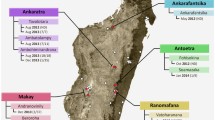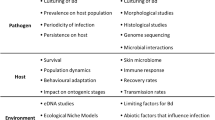Abstract
Batrachochytrium dendrobatidis (Bd) is commonly termed the ‘amphibian chytrid fungus’ but thus far has been documented to be a pathogen of only batrachian amphibians (anurans and caudatans). It is not proven to infect the limbless, generally poorly known, and mostly soil-dwelling caecilians (Gymnophiona). We conducted the largest qPCR survey of Bd in caecilians to date, for more than 200 field-swabbed specimens from five countries in Africa and South America, representing nearly 20 species, 12 genera, and 8 families. Positive results were recovered for 58 specimens from Tanzania and Cameroon (4 families, 6 genera, 6+ species). Quantities of Bd were not exceptionally high, with genomic equivalent (GE) values of 0.052–17.339. In addition, we report the first evidence of lethal chytridiomycosis in caecilians. Mortality in captive (wild-caught, commercial pet trade) Geotrypetes seraphini was associated with GE scores similar to those we detected for field-swabbed, wild animals.


Similar content being viewed by others
References
Berger L, Speare R, Daszak P, Green E, Cunningham AA, Goggin CL, Slocombe R, Ragan MA, Hyatt AD, McDonald KR, Hines HB, Lips KR, Marantelli G, Parkes H (1998) Chytridiomycosis causes amphibian mortality associated with population declines in the rain forests of Australia and Central America. Proceedings of the National Academy of Sciences of the United States of America 95:9031-9036
Berger L, Speare R, Hines HB, Marantelli G, Hyatt AD, McDonald KR, Skerratt LF, Olsen V, Clarke JM, Gillespie G, Mahony M, Sheppard N, Williams C, Tyler MJ (2004) Effects of season and temperature on mortality in amphibians due to chytridiomycosis. Australian Veterinary Journal 82:434-439
Boyle DG, Boyle DP, Olsen V, Morgan JAT, Hyatt AD (2004) Rapid quantitative detection of chytridiomycosis (Batrachochytrium dendrobatidis) in amphibian samples using real time Taqman PCR assay. Diseases of Aquatic Organisms 60:141–148
Conradie W, Weldon C, Smith KG, du Preez LH (2011) Seasonal pattern of chytridiomycosis in common river frog (Amietia angolensis) tadpoles in the South African grassland biome. African Zoology 46:95-102
Courtois EA, Pineau K, Vilette B, Schmeller DS, Gaucher P (2012) Population estimates of Dendrobates tinctorius (Anura: Dendrobatidae) at three sites in French Guiana and the first record of chytrid infection. Phyllomedusa 11:63-70
Doherty-Bone TM, Bielby J, Gonwouo NL, LeBreton M, Cunningham AA (2008) In a vulnerable position? Preliminary survey work fails to detect the amphibian chytrid pathogen in the highlands of Cameroon, an amphibian hotspot. Herpetological Journal 18:115-118
Doherty-Bone TM, Gonwouo NL, Hirschfeld M, Ohst T, Weldon C, Perkins M, Kouete MT, Browne RK, Loader SP, Gower DJ, Wilkinson M, Rödel M-O, Penner J, Barej MF, Schmitz A, Plötner J, Cunningham AA (2013) Batrachochytrium dendrobatidis in amphibians of Cameroon, including first records for caecilians. Diseases of Aquatic Organisms 102:187–194
Farrer RA, Weinert LA, Bielby J, Garner TWJ, Balloux F, Clare F, Bosch J, Cunningham AA, Weldon C, du Preez LH, Anderson L, Kosakovsky Pond SL, Shahar-Golan R, Henk DA, Fisher MC (2011) Multiple emergences of genetically diverse amphibian-infecting chytrids include a globalized hypervirulent recombinant lineage. Proceedings of the National Academy of Sciences of the United States of America 108:18732-18736
Fisher MC, garner Garner TWJ, Walker SF (2009a) Global emergence of Batrachochytrium dendrobatidis and amphibian chytridiomycosis in space, time, and host. Annual Reviews of Microbiology 63:291-310
Fisher MC, Bosch J, Yin Z, Stead DA, Walker J, Selway L, Brown AJP, Walker LA, Gow NAR, Stajich JE, Garner TWJ (2009b) Proteomic and phenotypic profiling of the amphibian pathogen Batrachochytrium dendrobatidis shows that phenotype is linked to virulence. Molecular Ecology 18:415-429
Fox H (1983) The skin of Ichthyophis (Amphibia: Caecilia): an ultrastructural study. Journal of Zoology, London 199:223-248
García G, Lopez J, Fa JE, Gray GAL (2009) Chytrid fungus strikes mountain chickens in Montserrat. Oryx 43:323-328
Garland S, Baker A, Phillott AD, Skerratt LF (2010) BSA reduces inhibition in a TaqMan assay for the detection of Batrachochytrium dendrobatidis. Diseases of Aquatic Organisms 92:113-116
Gower DJ, Wilkinson M (2005) Conservation biology of caecilian amphibians. Conservation Biology 19:45–55
Gower DJ, Doherty-Bone TM, Kassahun R, Mengistu A, Menegon M, de Sá R, Saber S, Cunningham AA, Loader SP (2012) High prevalence of the amphibian chytrid fungus (Batrachochytrium dendrobatidis) across multiple taxa and localities in the highlands of Ethiopia. Herpetological Journal 22: 225-233
Heyer WR, Donnelly MA, McDiarmid RW, Hayek LC, Foster MS (1994) Measuring and Monitoring Biological Diversity: Standard Methods for Amphibians. Washington, DC: Smithsonian Institution Press, 364 pp.
Hyatt AD, Boyle DG, Olsen V, Boyle DB, Berger L, Obendorf D, Datton A, Kriger K, Hero M, Hines H, Phillott R, Campbell R, Marantelli G, Gleason F, Colling A (2007) Diagnostic assays and sampling protocols for the detection of Batrachochytrium dendrobatidis. Diseases of Aquatic Organisms 73:175–192
James TY, Litvintseva AP, Vilgalys R, Morgan JA, Taylor JW, Fiisher MC, Berger L, Weldon C, du Preez L, Longcore JE (2009) Rapid global expansion of the fungal disease chytridiomycosis into declining and healthy amphibian populations. PLoS Pathogens 5(5):e1000458. doi:10.1371/journal.ppat.1000458
Kamei RG, San Mauro D, Gower DJ, van Bocxlaer I, Sherratt E, Thomas A, Babu S, Bossuyt F, Wilkinson M, Biju SD (2012) Discovery of a new family of amphibians from Northeast India with ancient links to Africa. Proceedings of the Royal Society 279:2396-2401
Kilpatrick AM, Briggs CJ, Daszak P (2010) The ecology and impact of chytridiomycosis: an emerging disease of amphibians. Trends in Ecology and Evolution 25:109-118
Kriger KM, Hero J-M (2007) Large-scale seasonal variation in the prevalence and severity of chytridiomycosis. Journal of Zoology, London 271:352-359
Lips KR (1999) Mass mortality and population declines of anurans at an upland site in western Panama. Conservation Biology 13:117-125
Longcore JE, Pessier AP, Nichols DK (1999) Batrachochytrium dendrobatidis gen. et sp. nov., a chytrid pathogenic to amphibians. Mycologia 91:219-27
Longo AV, Burrowes PA (2010) Persistence with chytridiomycosis does not assure survival of direct-developing frogs. Ecohealth 7:185-195
Lötters S, Kielgast J, Bielby J, Schmidtlein S, Bosch J, Veith M, Walker SF, Fisher MC, Rödder D (2010) The link between rapid enigmatic amphibian decline and the globally emerging chytrid fungus. EcoHealth 6:358-372
Luquet E, Garner TWJ, Léna J-P, Bruel C, Joly P, Lengagne T, Grolet O, Plénet S (2012) Genetic erosion in wild populations makes resistance to a pathogen more costly. Evolution 66:1942-1952
Penner J, Adum GB, McElroy MT, Doherty-Bone T, Hirschfeld M, Sandberger L, Weldon C, Cunningham AA, Ohst T, Wombwell E, Portik DM, Reid D, Hillers A, Ofori-Boateng C, Oduro W, Plötner J, Ohler A, Leaché AD, Rödel M-O (2013) West Africa - a safe haven for frogs? A regional assessment of the chytrid fungus (Batrachochytrium dendrobatidis). PLoS ONE 8(2):e56236. doi:10.1371/journal.pone.0056236
Piotrowski JS, Annis SL, Longcore JE (2004) Physiology of Batrachochytrium dendrobatidis, a chytrid pathogen of amphibians. Mycologia 96:9–15
Raphael BL, Pramuk J (2007) Treatment of chytrid infection in Typhlonectes spp. using elevated water temperatures. In: Proceedings of Amphibian Declines and Chytridiomycosis, Tempe, AZ, abstracts
Skerratt LF, Berger L, Speare R, Cashins S, McDonald KR, Phillott AD, Hines HB, Kenyon N (2007) Spread of chytridiomycosis has caused the rapid global decline and extinction of frogs. EcoHealth 4:125–134
Skerratt LF, Mendez D, McDonald KR, Garland S, Livingstone J, Berger L, Speare R (2011) Validation of diagnostic tests in wildlife: The case of chytridiomycosis in wild amphibians. Journal of Herpetology 45:444–450
Smith F (2011) The 2011 UK Chytrid Survey (aka The Big Swab 2011)—Protocol for Surveyors. London: Zoological Society of London, ARG-UK, DEFRA
Taylor EH (1968) Caecilians of the World: A Taxonomic Review. Lawrence: University of Kansas Press, 848 pp.
Vazquez VM, Rothermel BB, Pessier AP (2009) Experimental infection of North American plethodontid salamanders with the fungus Batrachochytrium dendrobatidis. Diseases of Aquatic Organisms 84:1-7
Weinstein SA (2009) An aquatic disease on a terrestrial salamander: Individual and population level effects of the amphibian chytrid fungus, Batrachochytrium dendrobatidis, on Batrachoseps attenuatus (Plethodontidae). Copeia 2009:653-660
Wilkinson M, San Mauro D, Sherratt E, Gower DJ (2011) A nine-family classification of caecilians (Amphibia: Gymnophiona). Zootaxa 2874:41-64
Acknowledgments
This research was funded, in part, by grants from the Declining Amphibian Population Task Force, National Geographic, Conservation International’s Lost Amphibians scheme, Critical Ecosystem Partnership Fund, Percy Sladen Memorial Fund of the Linnean Society, Systematics Association Research Fund, Institute of Zoology London, Zoological Society of London (Erasmus Darwin Barlow grant), Volkswagen Foundation, Royal Zoological Society of Scotland, Centre national de la recherché scientifique (Nouragues field station grant), The Morris Animal Foundation, and the Natural History Museum, London. Permits for research and export of samples were provided by the Cameroon Ministry of Forests and Wildlife to TMD-B (#0928), the Tanzania Commission for Science and Technology (COSTECH research permit RCA 2007-153, RCA 2004-335-ER-98-13 to SPL, MM), TAWIRI, and the Wildlife Division of Tanzania, and Direction des Services Vétérinaires de la Guyane, Cayenne, French Guiana to DJG and MW. DJG thanks Jennifer Pramuk for sharing unpublished information. For companionship and/or practical assistance in organizing and executing laboratory and fieldwork we thank many people local to field sites plus Andrés Rymel Acosta-Galvis, Gabriela Bittencourt, Patrick Chatelet, Jérôme Chave, Monica Donuyer, Céline Dupuy, Christopher Durrant, Devine Fotibu, Philippe Gaucher, Nono Gonwouo, Jon Gower, Roy and Zoe Hinde, Paul Kapange, Philippe Kok, Henry Kolem, Nicolas Krieger, Diego San Mauro, David and Roland Ndifon, Oscar Nyningchia, Maria Perkins, Matt Perkins, Ann Pocknell (Finn Pathologists), Clémence Poletto, Emma Sherratt, Guy Tiego, and Jeannot and Odette (Camp Patawa, French Guiana). For help with the care of captive caecilians at the Zoological Society of London we thank Toni Beadle, Joanna Korn, Heather Macintosh and Matthew Rendle.
Author information
Authors and Affiliations
Corresponding author
Appendix
Appendix
Coordinates in degrees for localities are included in Table 1. Data for each locality are approximate and given to two decimal places.
Cameroon
Banga Bakundu (4.41 N, 9.45 E), Dja (3.39 N, 13.12 E), Doumo-Pierre (3.47 N, 13.06 E), Kon (4.83 N, 11.06 E), Mt. Oku (6.22 N, 10.46 E), Mundame (4.57 N, 9.51 E), Ndikinimeki (4.75 N, 10.82 E), Ntengue (5.37 N, 10.02 E).
Colombia
Guarinócito (5.34 N, 74.74 W).
French Guiana
Angoulême (5.41 N, 53.65 W), Nouragues (4.06 N, 52.68 W), Kaw (4.54 N, 52.18 W).
Guyana
Iwokrama (4.33 N, 58.8 W).
Tanzania
Bagamoyo (6.48 S, 38.82 E), Maskati (6.06 S, 37.48 E), Nguu North FR (5.49 S, 37.49 E), Pemba (6 S, 37.55 E), Uluguru North FR (6.94 S, 37.71 E).
Rights and permissions
About this article
Cite this article
Gower, D.J., Doherty-Bone, T., Loader, S.P. et al. Batrachochytrium dendrobatidis Infection and Lethal Chytridiomycosis in Caecilian Amphibians (Gymnophiona). EcoHealth 10, 173–183 (2013). https://doi.org/10.1007/s10393-013-0831-9
Received:
Revised:
Accepted:
Published:
Issue Date:
DOI: https://doi.org/10.1007/s10393-013-0831-9




